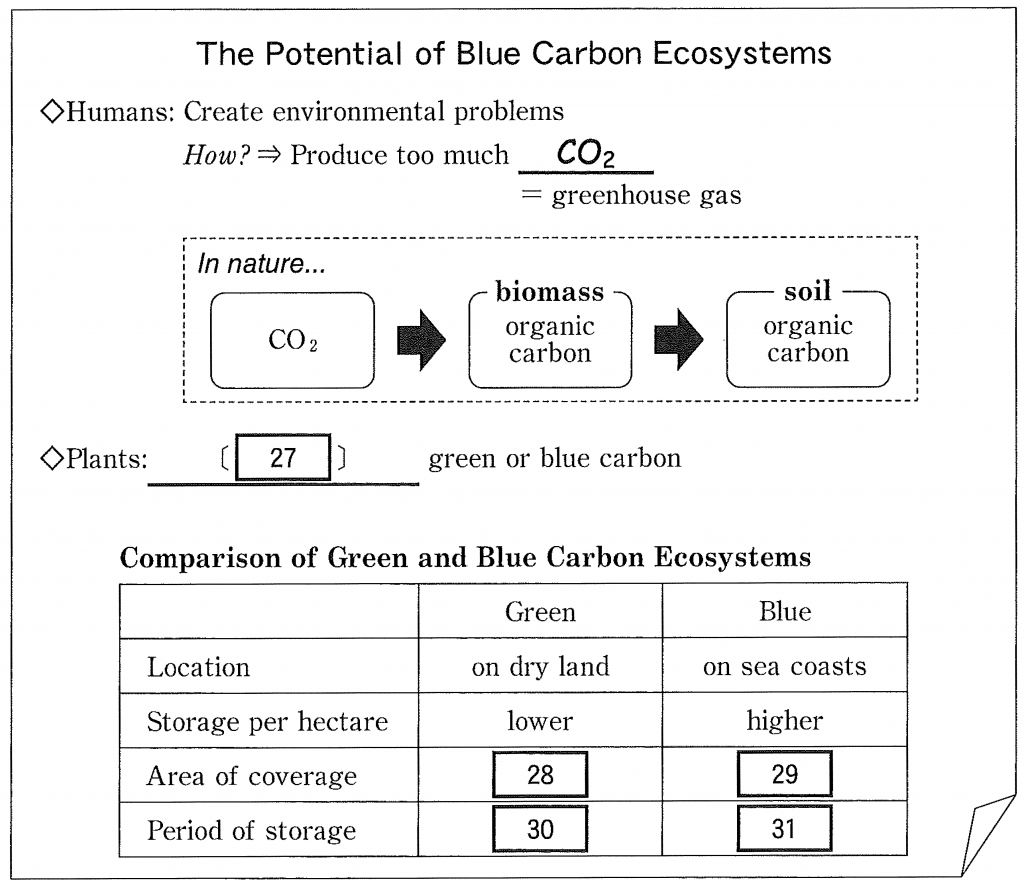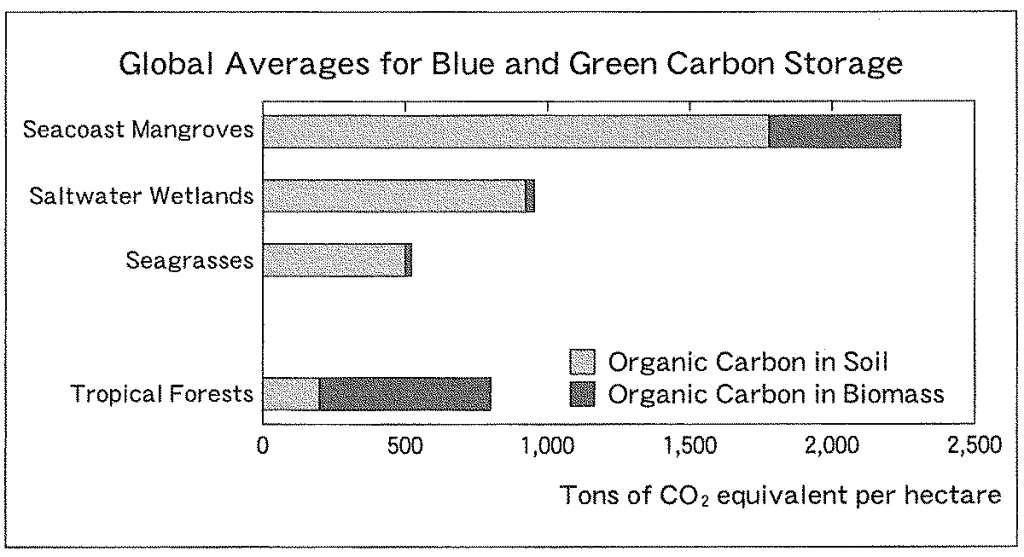【スマホで聞ける!スクリプト付き共通テスト過去問】英語(リスニング)2021本試第2日程(音声・問題・正解・和訳)
第5問
音声は1回流れます。
第5問は問27から問33の7問です。
問27~32
最初に講義を聞き,問27から問32に答えなさい。次に続きを聞き,問33に答えなさい。状況・ワークシート,問い及び図表を読む時間が与えられた後,音声が流れます。
状況
あなたはアメリカの大学で,生態系(ecosystem)保全についての講義を,ワークシートにメモを取りながら聞いています。
ワークシート

問27 ワークシートの空欄27に入れるのに最も適切なものを,四つの選択肢(①~④)うちから一つ選びなさい。
① Break down organic carbon called
② Change carbon to CO2 called
③ Produce oxygen and release it as
④ Take in CO2 and store it as
問28~31 ワークシートの空欄28~31に入れるのに最も適切なものを,六つの選択肢(①~⑥)のうちから一つずつ選びなさい。選択肢は2回以上使ってもかまいません。
① larger ② smaller
③ equal ④ longer
⑤ shorter ⑥ unknown
問32 講義の内容と一致するものはどれか。最も適切なものを,四つの選択肢(①~④)のうちから一つ選びなさい。
① Necessary blue carbon ecosystems have been destroyed and cannot be replaced.
② Ocean coastline ecosystems should be protected to prevent further release of CO2.
③ Recovering the ecosystem of the entire ocean will solve climate problems.
④ Supporting fish life is important for improving the blue carbon cycle.
問27 正解 4 問28 正解 1
問29 正解 2 問30 正解 5
問31 正解 4 問32 正解 2
OK. What is blue carbon? You know, humans produce too much CO2, a greenhouse gas. This creates problems with the earth’s climate. But remember how trees help us by absorbing CO2 from the air and releasing oxygen? Trees change CO2 into organic carbon, which is stored in biomass. Biomass includes things like leaves and trunks. The organic carbon in the biomass then goes into the soil. This organic carbon is called “green” carbon. But listen! Plants growing on ocean coasts can also take in and store CO2 as organic carbon in biomass and soil-just like trees on dry land do. That’s called “blue” carbon.
Blue carbon is created by seagrasses, mangroves, and plants in saltwater wetlands. These blue carbon ecosystems cover much less surface of the earth than is covered by green carbon forests. However, they store carbon very efficiently-much more carbon per hectare than green carbon forests do. The carbon in the soil of the ocean floor is covered by layers of mud, and can stay there for millions of years. In contrast, the carbon in land soil is so close to the surface that it can easily mix with air, and then be released as CO2.
Currently the blue carbon ecosystem is in trouble. For this ecosystem to work, it is absolutely necessary to look after ocean coasts. For example, large areas of mangroves are being destroyed. When this happens, great amounts of blue carbon are released back into the atmosphere as CO2. To avoid this, ocean coasts must be restored and protected. Additionally, healthy coastline ecosystems will support fish life, giving us even more benefits.
では。ブルーカーボンとは何でしょうか。みなさんご存知のように,人間は温室効果ガスであるCO2をあまりに多く生み出しています。これは,地球の気候に問題を作り出します。しかし,木が大気からCO2を吸収し,酸素を放出することによってどのように私たちに役立つか覚えていますか。木はCO2を有機炭素に変え,それはバイオマスに貯蔵されます。バイオマスは,葉や幹のようなものを含みます。そして,バイオマスの有機炭素は土壌に入ります。この有機炭素は「グリーン」カーボンと呼ばれます。しかし,聞いてください!海岸で育つ植物は,乾燥した土地の木とちょうど同じように,バイオマスや土壌の有機炭素としてCO2を取り込み,貯蔵できます。それは「ブルー」カーボンと呼ばれています。
ブルーカーボンは,海水の湿地で海草,マングローブ,植物によって作られます。これらのブルーカーボンの生態系は,グリーンカーボンの森で覆われているよりもはるかに少ない地球の表面を覆っています。しかし,それらは炭素は非常に効率良く炭素を貯蔵し,グリーンカーボンよりはるかに多くのヘクタールあたりの炭素を貯蔵します。海底の土壌中の炭素は泥の層で覆われており,何百万年もそこにとどまることができます。対照的に,陸地の土壌中の炭素は表面にあまりに近いため,それは簡単に空気と混ざり,そしてCO2として放出されます。
現在,ブルーカーボンの生態系は困難な状況にあります。この生態系が機能するためには,海岸の世話をすることが絶対に必要です。たとえば,マングローブの広い地域が破壊されています。これが起こるとき,大量のブルーカーボンがCO2として大気中に放出されます。これを避けるためには,海岸は復元され,保護されねければなりません。さらに,健全な海岸線の生態系は魚の命を支え,私たちにさらに多くの利益を与えるでしょう。
ワークシート
ブルーカーボン生態系の可能性
♢人間:環境問題を作り出す
どのように⇒あまりに多くのCO2を作り出す
=温室効果ガス
自然では・・・
♢植物:〔27〕⇒グリーンまたはブルーカーボン
問27
① (グリーンまたはブルーカーボン)と呼ばれる有機炭素を破壊する
② (グリーンまたはブルーカーボン)と呼ばれる炭素をCO2に変える
③ 酸素を作り出し,それを(グリーンまたはブルーカーボン)として放出する
④ CO2を取り込み,それを(グリーンまたはブルーカーボン)として貯蔵する
問28~31
① より広い ② より狭い
③ 等しい ④ より長い
⑤ より短い ⑥ 分からない
問32
① 必要なブルーカーボン生態系が破壊され,置きかえることはできない。
② CO2のさらなる放出を防ぐために,海の海岸線の生態系を保護しなければならない。
③ 海洋全体の生態系を回復することは,気候の問題を解決する。
④ 魚の命を支えることは,ブルーカーボンの循環を改善するために重要である。
問33
講義の続きを聞き,下の図から読み取れる情報と講義全体の内容からどのようなことが言えるか,最も適切なものを,四つの選択肢(①~④)のうちから一つ選びなさい。

① Saltwater wetlands release CO2 more easily from soil than from biomass.
② Seacoast mangroves release less CO2 from layers of mud than from biomass.
③ Seagrasses offer more efficient long-term carbon storage in soil than in biomass.
④ Tropical forests are ideal for carbon storage due to their biomass.
問33 正解 3
Look at this graph, which compares blue and green carbon storage. Notice how much organic carbon is stored in each of the four places. The organic carbon is stored in soil and in biomass but in different proportions. What can we learn from this?
ブルーカーボンとグリーンカーボンの貯蔵量を比較したこのグラフを見てください。4つの場所のそれぞれにどれだけの有機炭素が貯蔵されているかに注目してください。有機炭素は土壌とバイオマスに貯蔵されますが,異なる比率です。私たちはこれから何を学ぶことができますか。
① 海水の湿地は,バイオマスよりも土壌からより簡単にCO2を放出する。
② 海岸のマングローブは,バイオマスよりも泥の層からCO2をより少なく放出する。
③ 海草は,バイオマスよりも土壌中の方がより効率的な長期の炭素貯蔵を提供する。
④ 熱帯林は,そのバイオマスのおかげで,炭素貯蔵にとって理想的である。
SNSでシェア